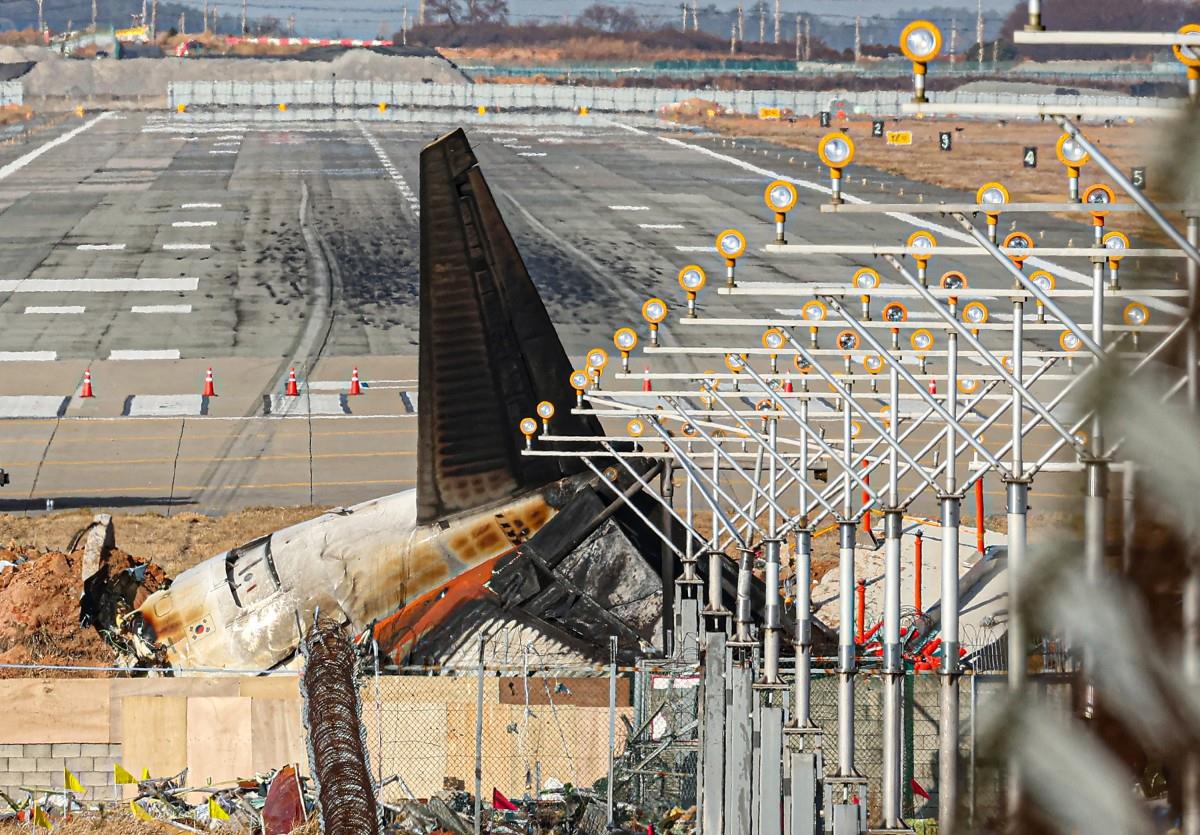
What Caused South Korea's Most Deadly Plane Crash
Seoul: The emergency landing of Jeju Air Flight 2216 looked highly skilled, experts say, but all except two of the 181 people on board were killed when the Boeing 737-800 hit a wall and burst into flames.
As South Korean investigators probe the causes of the country's worst-ever aviation disaster on home soil, AFP takes a look at what could have gone wrong:
What happened?
The flight from Bangkok to southwestern Muan International Airport in South Korea was warned of a bird strike by the control tower as it came in to land.
Minutes later, the pilot issued a mayday call before attempting an emergency landing -- with video showing the plane coming down on the runway without its landing gear engaged.
This photo shows an abnormal flame coming out of the right engine of the Jeju Air Boeing 737-800 series aircraft as it comes to land before crashing and bursting into flames at Muan International Airport in South Jeolla Province, some 288 kilometres southwest of Seoul on December 29, 2024. Photo by YONHAP / AFP.
Bird strikes can cause fires inside the plane's engines, damaging critical systems which can render the landing gear inoperable -- meaning the wheels don't come out to facilitate a smooth landing, said former pilot Kim Kwang-il.
A "belly landing" is an emergency procedure for precisely this scenario and planes are designed to withstand this in emergencies, Kim, also a professor at Silla University Aeronautical Science, told AFP.
Screen grab of a video of the Jeju Air plane performing a belly landing.
"In this particular case, the pilot executed the belly landing exceptionally well," he said, saying the plane came in "like a swan gracefully landing on a lake, slightly tilted backward for a smooth descent."
"Considering the emergency, the landing was remarkably well-executed."
What went wrong?
Video shows the plane hitting a barrier, prompting it to burst into flames.
Only two people were rescued, both airline crew plucked from the tail of the plane.
Kim said he was "quite upset" to see the collision with the wall, saying there should not have been any solid structures in the area, to allow for emergency landings -- and if the wall had not been there, lives could have been saved, he said.
"Most of the passengers died because of this obstruction, which is devastating," he said.
"While the bird strike, or 'act of God,' was the root cause of the accident and unavoidable, the presence of this structure turned it into a tragedy," he said, as without it, the plane could have skidded to a safe stop.
What was this barrier?
Deputy minister for Civil Aviation Joo Jong-wan said the barrier was a so-called localiser, which is a " type of navigational aid."
"The specific foundation on which these devices are placed varies depending on the airport," he said, with no "standardised or uniform design."
Recovery teams work at the scene where a Jeju Air Boeing 737-800 series aircraft crashed and burst into flames at Muan International Airport in Muan. Photo by JUNG YEON-JE / AFP.
At Muan, like several other airports in South Korea, the localisers were on "piled-up soil, and concrete structures have been installed within these soil layers," he said.
"The connection between these localisers and the accident will be thoroughly examined during the investigation process," Joo added.
And the birds?
Muan is in a wetland area, popular with migratory birds, and deputy minister Joo said that the airport had long taken measures to minimise bird intrusions affecting flights.
"These measures include the use of bird repellents, activities to deter birds, removal of habitats, blocking drainage channels to prevent attraction within the airport," Joo said.
It was likely ducks, common in the area, played a key role in the accident, said Choi Chang-yong, professor at Seoul National University's forest sciences department.
File photo used for representational purposes.
"Because planes move much faster than birds can perceive or evade, they likely couldn't react in time," he said, adding that birds also often collide with cars for this reason.
In winter, Muan attracts "ducks and geese, such as northern pintails and other species," in significant numbers, he said.
Muan has the highest bird strike rate of all South Korea's 14 airports, except for the country's largest airport Incheon, according to statistics from the land ministry and the Korea Airports Corporation.
Its strike rate from 2019 to August 2024 was 0.09 percent -- nine bird strikes for every 10,000 flights, five times more than Seoul's second airport Gimpo.
Experts claim Muan's Bird Strike Prevention Committee is not well staffed and doesn't function effectively. Only one person was working to prevent bird strikes on the day of the accident, local media Herald Corporation reported.
Was it the plane?
Immediately after the crash, some online speculation focused on the aircraft, a Boeing 737-800, and whether it could be at fault.
File photo used for demonstration purposes.
Jeju Air said that 39 out of its 41 aircraft are Boeing B737-800s -- making it the largest South Korean operator of this model.
South Korea said Monday it was launching a "comprehensive inspection" of all 101 Boeing 737-800 aircraft operated by the country's carriers.
Boeing was under fire after Maneuvering Characteristics Augmentation System (MCAS), a flight stabilising feature, was implicated in a series of crashes involving its 737 MAX jetliners, which killed hundreds of people.
After two 737 MAX crashes -- a 2019 Ethiopian Airlines crash and 2018 Lion Air crash -- the entire 737 MAX fleet were grounded for more than 20 months for authorities to investigate.

Legal Disclaimer:
MENAFN provides the information “as is” without warranty of any kind. We do not accept any responsibility or liability for the accuracy, content, images, videos, licenses, completeness, legality, or reliability of the information contained in this article. If you have any complaints or copyright issues related to this article, kindly contact the provider above.






















Comments
No comment